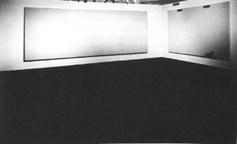Robert Slifkin: The Empty Room and the End of Man
Thursday 26 March 2020 starting at 7:00 p.m.
VANDENHOVE Centre for Architecture and Art
Rozier 1, 9000 Gent.
The lecture is held in English and open to all public.

Drawing upon the original reception of some of the most significant public exhibitions of minimal and postminimal art (taking the work of William Anastasi, Dan Flavin, Robert Barry, and Bruce Nauman as key examples) this paper will argue that these works and ‘environments’ (to use a word often invoked around such art) produced experiential situations that served as imaginary figurations of what the world would look and feel like without human inhabitation or if the viewer was the last person on the Earth. Yet the works’ characteristically spartan simplicity and attention to raw materiality also figured a possible future world uncluttered by unnecessary possessions, a world, according to theorists like Buckminster Fuller and Herbert Marcuse, that would distribute resources equitably and thus make warfare obsolete.
By creating works that imagine uninhabitable or empty physical spaces or, through their massive size or spatial expansiveness, encourage a mode of spectatorship and photographic reproduction that occludes other people, these works channelled a larger cultural anxiety concerning the threat of nuclear annihilation and the need for economic and political justices that fundamentally inflected, however unconsciously, significant realms of postwar American culture well into the 1970s.
Bio:
Robert Slifkin is associate professor of fine arts at New York University's Institute of Fine Arts. He holds a Ph.D. in Art History of Yale University. Slifkin is scholar of modern art with a specialization in the art and culture of the United States since 1945. His research aims to expand and complicate the conventional understanding of the history of modern art by considering the ways in which works of art operate within complex cultural networks that inform aspects of aesthetic production and reception. He is the author of The New Monuments and the End of Man: U.S. Sculpture Between War and Peace, 1945–1975 (Princeton University Press, 2019) and Out of Time: Philip Guston and the Refiguration of Postwar American Art (Berkeley University Press, 2013).